Comprehensive Analysis: Trends in Global Environment Article Report
VerifiedAdded on 2021/06/17
|9
|1985
|45
Report
AI Summary
This report provides an analysis of an article focusing on trends in the global environment, particularly concerning the application of algorithms in business. The article emphasizes the importance of managers understanding algorithms for effective decision-making, highlighting examples like Netflix and social media advertising. Key questions addressed include the risks of smart algorithms, managerial approaches to business goals, minimizing myopic vision, and selecting appropriate data inputs. The literature review explores these questions through various sources, including works on network control, change management, workflow scheduling, and density estimation. The analysis covers the complexities of algorithm control, the need for explicit business goals, efficient workflow execution, and the selection of relevant data, with considerations for limitations and potential risks. The report underscores the necessity of continuous learning, training, and the use of tools like workflow engine simulators and density estimation techniques for informed decision-making and achieving business objectives. It also highlights the importance of recognizing patterns, managing potential risks, and making data-driven decisions.

Running head: TRENDS IN GLOBAL ENVIRONMENT
Article analysis
Name of the student:
Name of the university:
Author note:
Article analysis
Name of the student:
Name of the university:
Author note:
Paraphrase This Document
Need a fresh take? Get an instant paraphrase of this document with our AI Paraphraser

1
TRENDS IN GLOBAL ENVIRONMENT
Table of contents
Summary of the article...............................................................................................................2
Key questions.............................................................................................................................2
Literature review........................................................................................................................3
References..................................................................................................................................8
TRENDS IN GLOBAL ENVIRONMENT
Table of contents
Summary of the article...............................................................................................................2
Key questions.............................................................................................................................2
Literature review........................................................................................................................3
References..................................................................................................................................8
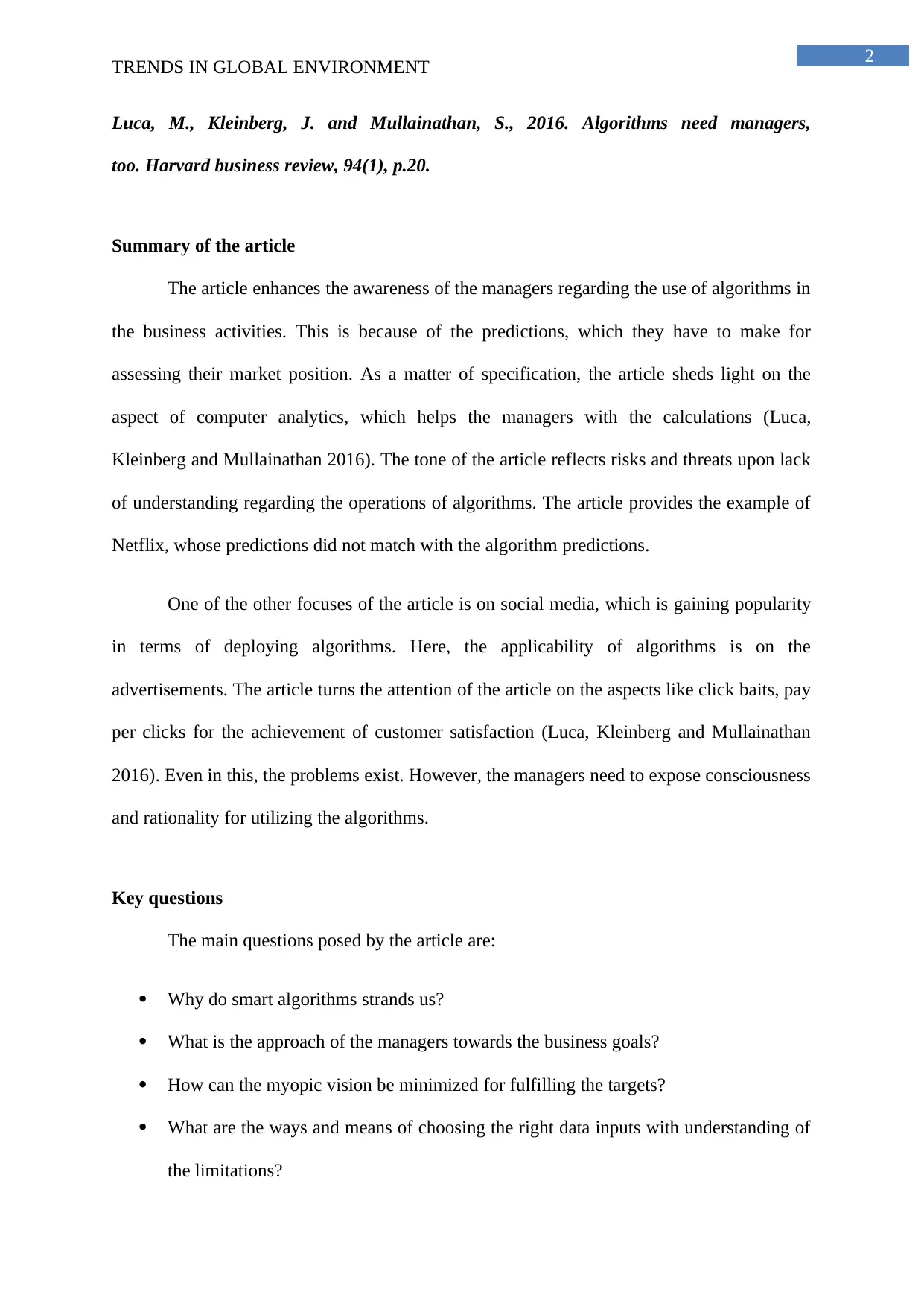
2
TRENDS IN GLOBAL ENVIRONMENT
Luca, M., Kleinberg, J. and Mullainathan, S., 2016. Algorithms need managers,
too. Harvard business review, 94(1), p.20.
Summary of the article
The article enhances the awareness of the managers regarding the use of algorithms in
the business activities. This is because of the predictions, which they have to make for
assessing their market position. As a matter of specification, the article sheds light on the
aspect of computer analytics, which helps the managers with the calculations (Luca,
Kleinberg and Mullainathan 2016). The tone of the article reflects risks and threats upon lack
of understanding regarding the operations of algorithms. The article provides the example of
Netflix, whose predictions did not match with the algorithm predictions.
One of the other focuses of the article is on social media, which is gaining popularity
in terms of deploying algorithms. Here, the applicability of algorithms is on the
advertisements. The article turns the attention of the article on the aspects like click baits, pay
per clicks for the achievement of customer satisfaction (Luca, Kleinberg and Mullainathan
2016). Even in this, the problems exist. However, the managers need to expose consciousness
and rationality for utilizing the algorithms.
Key questions
The main questions posed by the article are:
Why do smart algorithms strands us?
What is the approach of the managers towards the business goals?
How can the myopic vision be minimized for fulfilling the targets?
What are the ways and means of choosing the right data inputs with understanding of
the limitations?
TRENDS IN GLOBAL ENVIRONMENT
Luca, M., Kleinberg, J. and Mullainathan, S., 2016. Algorithms need managers,
too. Harvard business review, 94(1), p.20.
Summary of the article
The article enhances the awareness of the managers regarding the use of algorithms in
the business activities. This is because of the predictions, which they have to make for
assessing their market position. As a matter of specification, the article sheds light on the
aspect of computer analytics, which helps the managers with the calculations (Luca,
Kleinberg and Mullainathan 2016). The tone of the article reflects risks and threats upon lack
of understanding regarding the operations of algorithms. The article provides the example of
Netflix, whose predictions did not match with the algorithm predictions.
One of the other focuses of the article is on social media, which is gaining popularity
in terms of deploying algorithms. Here, the applicability of algorithms is on the
advertisements. The article turns the attention of the article on the aspects like click baits, pay
per clicks for the achievement of customer satisfaction (Luca, Kleinberg and Mullainathan
2016). Even in this, the problems exist. However, the managers need to expose consciousness
and rationality for utilizing the algorithms.
Key questions
The main questions posed by the article are:
Why do smart algorithms strands us?
What is the approach of the managers towards the business goals?
How can the myopic vision be minimized for fulfilling the targets?
What are the ways and means of choosing the right data inputs with understanding of
the limitations?
⊘ This is a preview!⊘
Do you want full access?
Subscribe today to unlock all pages.

Trusted by 1+ million students worldwide
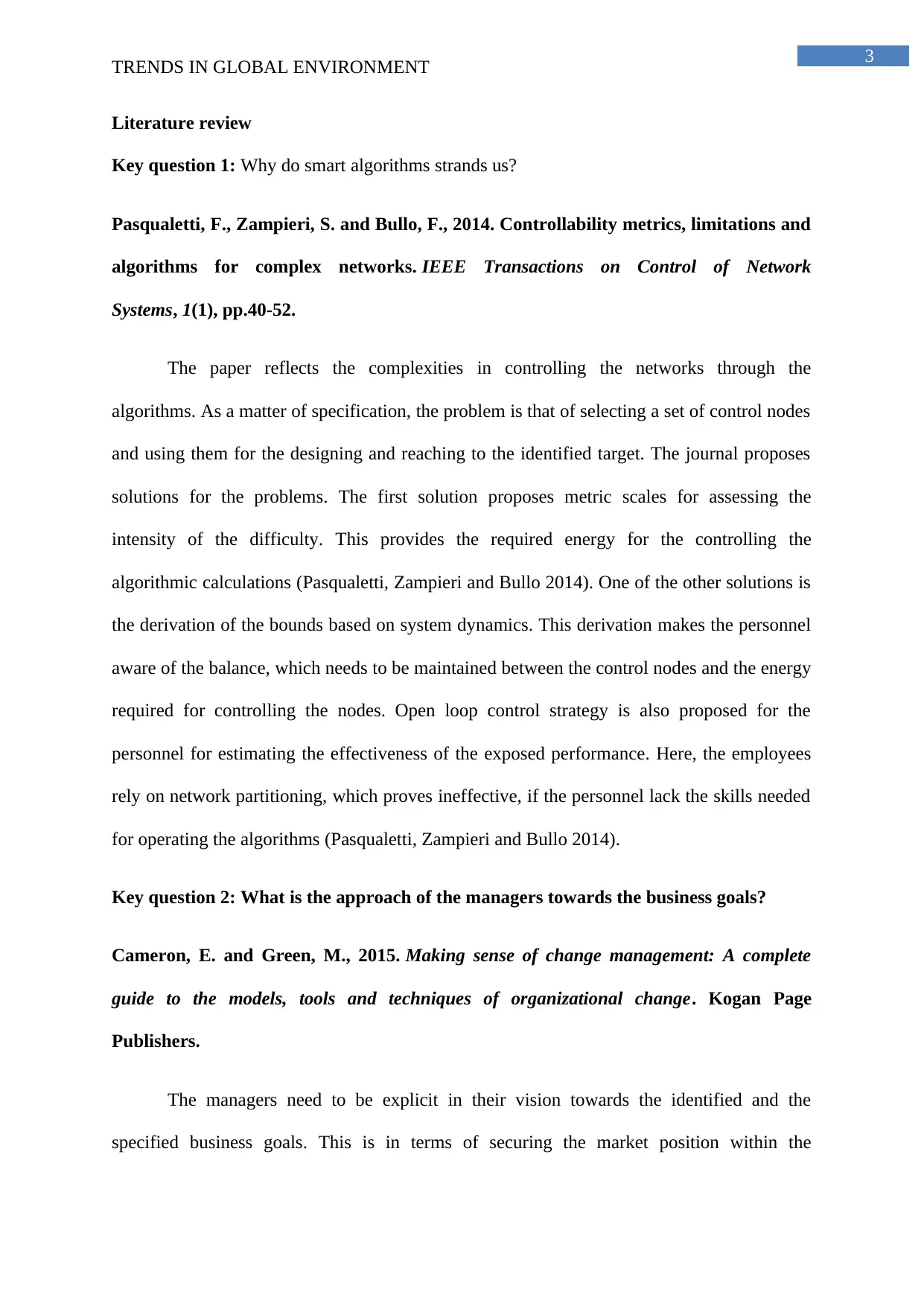
3
TRENDS IN GLOBAL ENVIRONMENT
Literature review
Key question 1: Why do smart algorithms strands us?
Pasqualetti, F., Zampieri, S. and Bullo, F., 2014. Controllability metrics, limitations and
algorithms for complex networks. IEEE Transactions on Control of Network
Systems, 1(1), pp.40-52.
The paper reflects the complexities in controlling the networks through the
algorithms. As a matter of specification, the problem is that of selecting a set of control nodes
and using them for the designing and reaching to the identified target. The journal proposes
solutions for the problems. The first solution proposes metric scales for assessing the
intensity of the difficulty. This provides the required energy for the controlling the
algorithmic calculations (Pasqualetti, Zampieri and Bullo 2014). One of the other solutions is
the derivation of the bounds based on system dynamics. This derivation makes the personnel
aware of the balance, which needs to be maintained between the control nodes and the energy
required for controlling the nodes. Open loop control strategy is also proposed for the
personnel for estimating the effectiveness of the exposed performance. Here, the employees
rely on network partitioning, which proves ineffective, if the personnel lack the skills needed
for operating the algorithms (Pasqualetti, Zampieri and Bullo 2014).
Key question 2: What is the approach of the managers towards the business goals?
Cameron, E. and Green, M., 2015. Making sense of change management: A complete
guide to the models, tools and techniques of organizational change. Kogan Page
Publishers.
The managers need to be explicit in their vision towards the identified and the
specified business goals. This is in terms of securing the market position within the
TRENDS IN GLOBAL ENVIRONMENT
Literature review
Key question 1: Why do smart algorithms strands us?
Pasqualetti, F., Zampieri, S. and Bullo, F., 2014. Controllability metrics, limitations and
algorithms for complex networks. IEEE Transactions on Control of Network
Systems, 1(1), pp.40-52.
The paper reflects the complexities in controlling the networks through the
algorithms. As a matter of specification, the problem is that of selecting a set of control nodes
and using them for the designing and reaching to the identified target. The journal proposes
solutions for the problems. The first solution proposes metric scales for assessing the
intensity of the difficulty. This provides the required energy for the controlling the
algorithmic calculations (Pasqualetti, Zampieri and Bullo 2014). One of the other solutions is
the derivation of the bounds based on system dynamics. This derivation makes the personnel
aware of the balance, which needs to be maintained between the control nodes and the energy
required for controlling the nodes. Open loop control strategy is also proposed for the
personnel for estimating the effectiveness of the exposed performance. Here, the employees
rely on network partitioning, which proves ineffective, if the personnel lack the skills needed
for operating the algorithms (Pasqualetti, Zampieri and Bullo 2014).
Key question 2: What is the approach of the managers towards the business goals?
Cameron, E. and Green, M., 2015. Making sense of change management: A complete
guide to the models, tools and techniques of organizational change. Kogan Page
Publishers.
The managers need to be explicit in their vision towards the identified and the
specified business goals. This is in terms of securing the market position within the
Paraphrase This Document
Need a fresh take? Get an instant paraphrase of this document with our AI Paraphraser
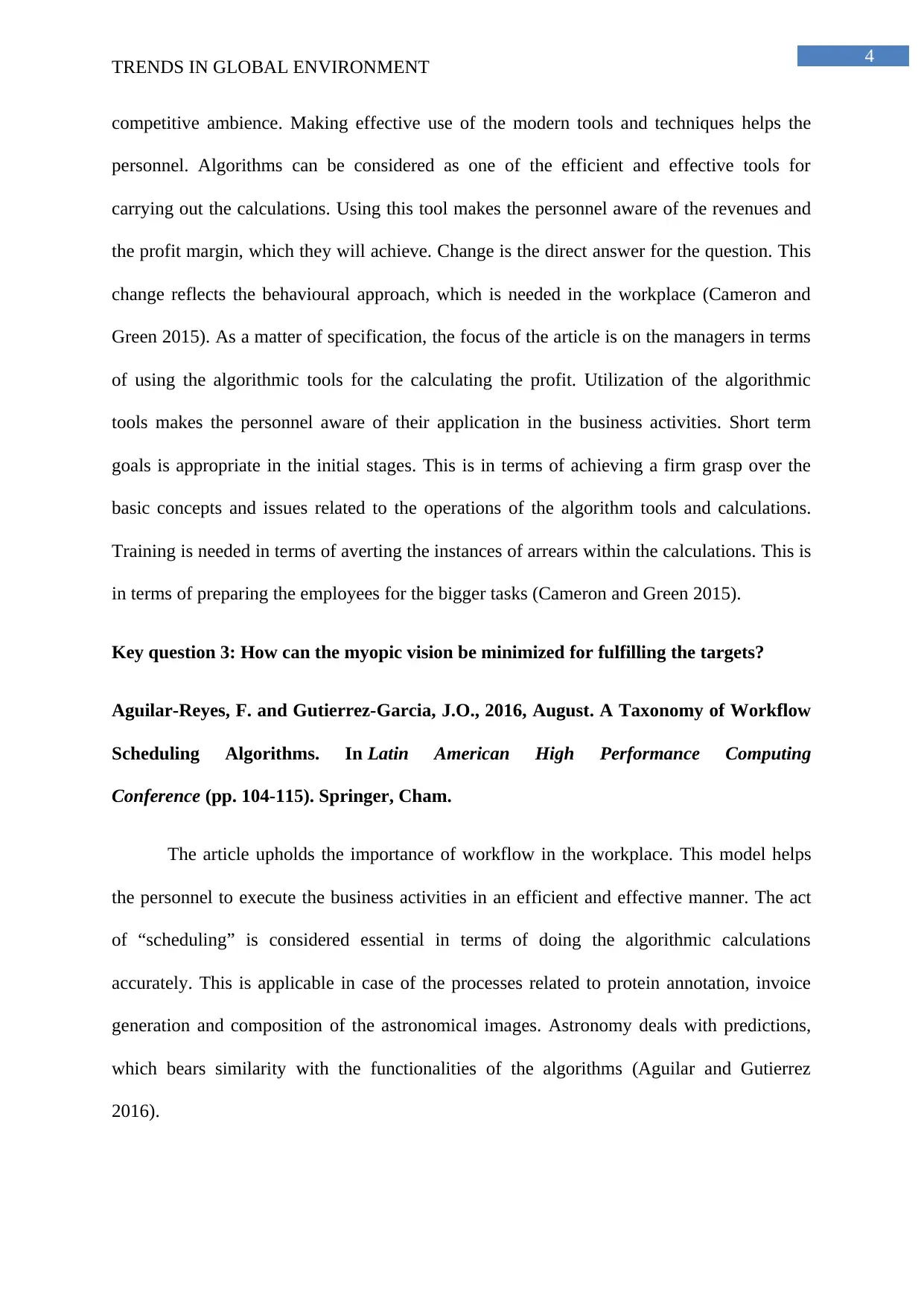
4
TRENDS IN GLOBAL ENVIRONMENT
competitive ambience. Making effective use of the modern tools and techniques helps the
personnel. Algorithms can be considered as one of the efficient and effective tools for
carrying out the calculations. Using this tool makes the personnel aware of the revenues and
the profit margin, which they will achieve. Change is the direct answer for the question. This
change reflects the behavioural approach, which is needed in the workplace (Cameron and
Green 2015). As a matter of specification, the focus of the article is on the managers in terms
of using the algorithmic tools for the calculating the profit. Utilization of the algorithmic
tools makes the personnel aware of their application in the business activities. Short term
goals is appropriate in the initial stages. This is in terms of achieving a firm grasp over the
basic concepts and issues related to the operations of the algorithm tools and calculations.
Training is needed in terms of averting the instances of arrears within the calculations. This is
in terms of preparing the employees for the bigger tasks (Cameron and Green 2015).
Key question 3: How can the myopic vision be minimized for fulfilling the targets?
Aguilar-Reyes, F. and Gutierrez-Garcia, J.O., 2016, August. A Taxonomy of Workflow
Scheduling Algorithms. In Latin American High Performance Computing
Conference (pp. 104-115). Springer, Cham.
The article upholds the importance of workflow in the workplace. This model helps
the personnel to execute the business activities in an efficient and effective manner. The act
of “scheduling” is considered essential in terms of doing the algorithmic calculations
accurately. This is applicable in case of the processes related to protein annotation, invoice
generation and composition of the astronomical images. Astronomy deals with predictions,
which bears similarity with the functionalities of the algorithms (Aguilar and Gutierrez
2016).
TRENDS IN GLOBAL ENVIRONMENT
competitive ambience. Making effective use of the modern tools and techniques helps the
personnel. Algorithms can be considered as one of the efficient and effective tools for
carrying out the calculations. Using this tool makes the personnel aware of the revenues and
the profit margin, which they will achieve. Change is the direct answer for the question. This
change reflects the behavioural approach, which is needed in the workplace (Cameron and
Green 2015). As a matter of specification, the focus of the article is on the managers in terms
of using the algorithmic tools for the calculating the profit. Utilization of the algorithmic
tools makes the personnel aware of their application in the business activities. Short term
goals is appropriate in the initial stages. This is in terms of achieving a firm grasp over the
basic concepts and issues related to the operations of the algorithm tools and calculations.
Training is needed in terms of averting the instances of arrears within the calculations. This is
in terms of preparing the employees for the bigger tasks (Cameron and Green 2015).
Key question 3: How can the myopic vision be minimized for fulfilling the targets?
Aguilar-Reyes, F. and Gutierrez-Garcia, J.O., 2016, August. A Taxonomy of Workflow
Scheduling Algorithms. In Latin American High Performance Computing
Conference (pp. 104-115). Springer, Cham.
The article upholds the importance of workflow in the workplace. This model helps
the personnel to execute the business activities in an efficient and effective manner. The act
of “scheduling” is considered essential in terms of doing the algorithmic calculations
accurately. This is applicable in case of the processes related to protein annotation, invoice
generation and composition of the astronomical images. Astronomy deals with predictions,
which bears similarity with the functionalities of the algorithms (Aguilar and Gutierrez
2016).
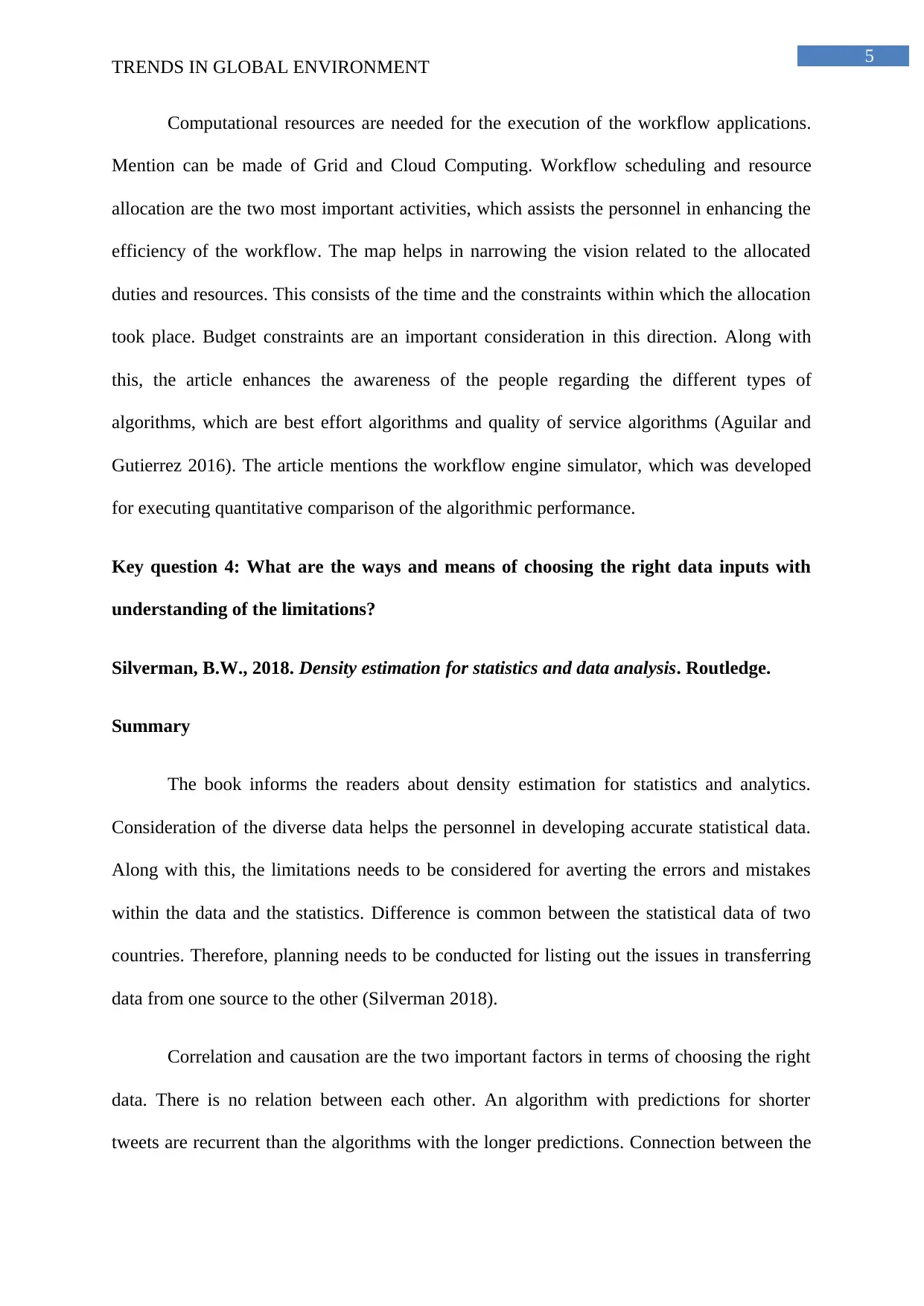
5
TRENDS IN GLOBAL ENVIRONMENT
Computational resources are needed for the execution of the workflow applications.
Mention can be made of Grid and Cloud Computing. Workflow scheduling and resource
allocation are the two most important activities, which assists the personnel in enhancing the
efficiency of the workflow. The map helps in narrowing the vision related to the allocated
duties and resources. This consists of the time and the constraints within which the allocation
took place. Budget constraints are an important consideration in this direction. Along with
this, the article enhances the awareness of the people regarding the different types of
algorithms, which are best effort algorithms and quality of service algorithms (Aguilar and
Gutierrez 2016). The article mentions the workflow engine simulator, which was developed
for executing quantitative comparison of the algorithmic performance.
Key question 4: What are the ways and means of choosing the right data inputs with
understanding of the limitations?
Silverman, B.W., 2018. Density estimation for statistics and data analysis. Routledge.
Summary
The book informs the readers about density estimation for statistics and analytics.
Consideration of the diverse data helps the personnel in developing accurate statistical data.
Along with this, the limitations needs to be considered for averting the errors and mistakes
within the data and the statistics. Difference is common between the statistical data of two
countries. Therefore, planning needs to be conducted for listing out the issues in transferring
data from one source to the other (Silverman 2018).
Correlation and causation are the two important factors in terms of choosing the right
data. There is no relation between each other. An algorithm with predictions for shorter
tweets are recurrent than the algorithms with the longer predictions. Connection between the
TRENDS IN GLOBAL ENVIRONMENT
Computational resources are needed for the execution of the workflow applications.
Mention can be made of Grid and Cloud Computing. Workflow scheduling and resource
allocation are the two most important activities, which assists the personnel in enhancing the
efficiency of the workflow. The map helps in narrowing the vision related to the allocated
duties and resources. This consists of the time and the constraints within which the allocation
took place. Budget constraints are an important consideration in this direction. Along with
this, the article enhances the awareness of the people regarding the different types of
algorithms, which are best effort algorithms and quality of service algorithms (Aguilar and
Gutierrez 2016). The article mentions the workflow engine simulator, which was developed
for executing quantitative comparison of the algorithmic performance.
Key question 4: What are the ways and means of choosing the right data inputs with
understanding of the limitations?
Silverman, B.W., 2018. Density estimation for statistics and data analysis. Routledge.
Summary
The book informs the readers about density estimation for statistics and analytics.
Consideration of the diverse data helps the personnel in developing accurate statistical data.
Along with this, the limitations needs to be considered for averting the errors and mistakes
within the data and the statistics. Difference is common between the statistical data of two
countries. Therefore, planning needs to be conducted for listing out the issues in transferring
data from one source to the other (Silverman 2018).
Correlation and causation are the two important factors in terms of choosing the right
data. There is no relation between each other. An algorithm with predictions for shorter
tweets are recurrent than the algorithms with the longer predictions. Connection between the
⊘ This is a preview!⊘
Do you want full access?
Subscribe today to unlock all pages.

Trusted by 1+ million students worldwide
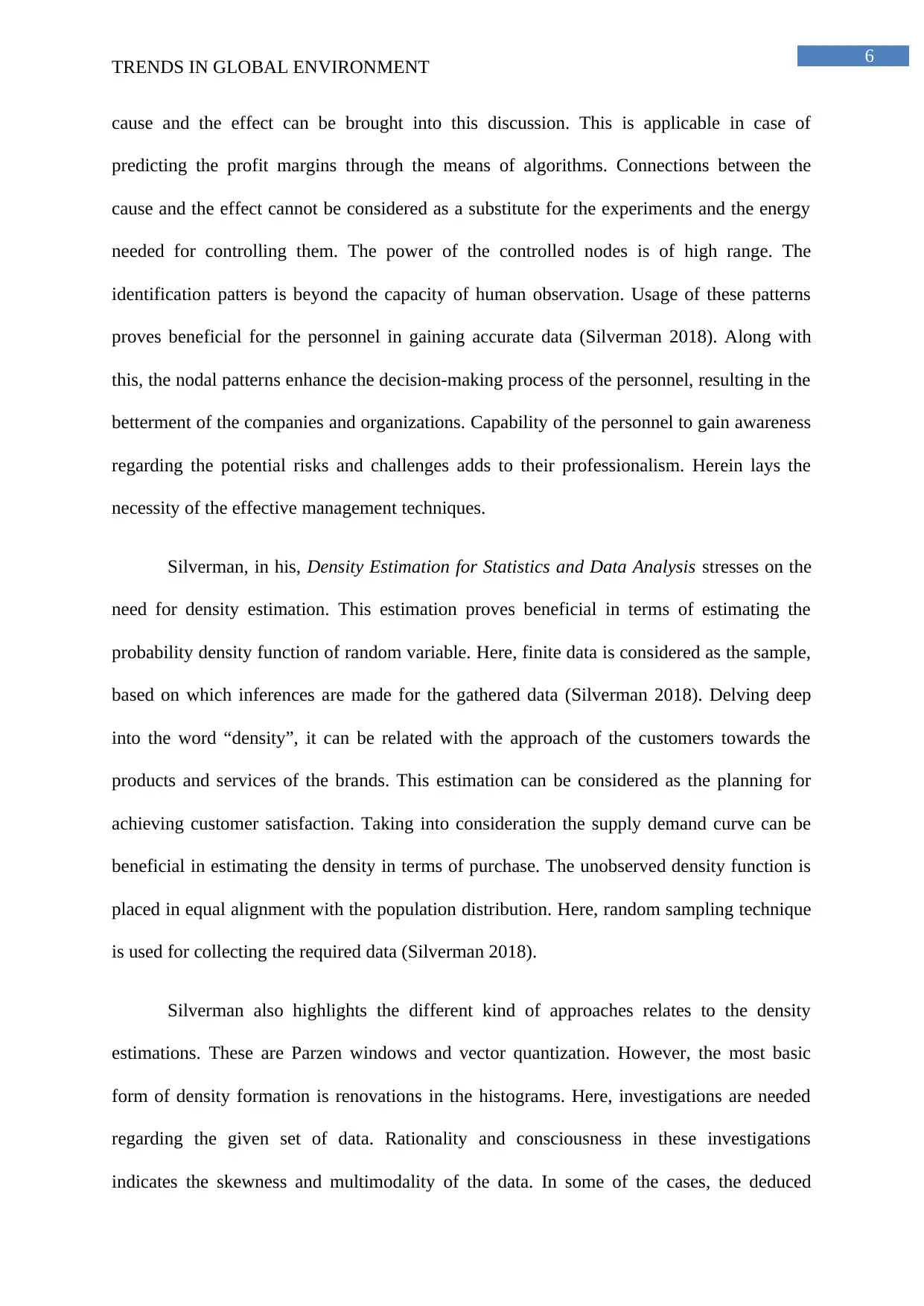
6
TRENDS IN GLOBAL ENVIRONMENT
cause and the effect can be brought into this discussion. This is applicable in case of
predicting the profit margins through the means of algorithms. Connections between the
cause and the effect cannot be considered as a substitute for the experiments and the energy
needed for controlling them. The power of the controlled nodes is of high range. The
identification patters is beyond the capacity of human observation. Usage of these patterns
proves beneficial for the personnel in gaining accurate data (Silverman 2018). Along with
this, the nodal patterns enhance the decision-making process of the personnel, resulting in the
betterment of the companies and organizations. Capability of the personnel to gain awareness
regarding the potential risks and challenges adds to their professionalism. Herein lays the
necessity of the effective management techniques.
Silverman, in his, Density Estimation for Statistics and Data Analysis stresses on the
need for density estimation. This estimation proves beneficial in terms of estimating the
probability density function of random variable. Here, finite data is considered as the sample,
based on which inferences are made for the gathered data (Silverman 2018). Delving deep
into the word “density”, it can be related with the approach of the customers towards the
products and services of the brands. This estimation can be considered as the planning for
achieving customer satisfaction. Taking into consideration the supply demand curve can be
beneficial in estimating the density in terms of purchase. The unobserved density function is
placed in equal alignment with the population distribution. Here, random sampling technique
is used for collecting the required data (Silverman 2018).
Silverman also highlights the different kind of approaches relates to the density
estimations. These are Parzen windows and vector quantization. However, the most basic
form of density formation is renovations in the histograms. Here, investigations are needed
regarding the given set of data. Rationality and consciousness in these investigations
indicates the skewness and multimodality of the data. In some of the cases, the deduced
TRENDS IN GLOBAL ENVIRONMENT
cause and the effect can be brought into this discussion. This is applicable in case of
predicting the profit margins through the means of algorithms. Connections between the
cause and the effect cannot be considered as a substitute for the experiments and the energy
needed for controlling them. The power of the controlled nodes is of high range. The
identification patters is beyond the capacity of human observation. Usage of these patterns
proves beneficial for the personnel in gaining accurate data (Silverman 2018). Along with
this, the nodal patterns enhance the decision-making process of the personnel, resulting in the
betterment of the companies and organizations. Capability of the personnel to gain awareness
regarding the potential risks and challenges adds to their professionalism. Herein lays the
necessity of the effective management techniques.
Silverman, in his, Density Estimation for Statistics and Data Analysis stresses on the
need for density estimation. This estimation proves beneficial in terms of estimating the
probability density function of random variable. Here, finite data is considered as the sample,
based on which inferences are made for the gathered data (Silverman 2018). Delving deep
into the word “density”, it can be related with the approach of the customers towards the
products and services of the brands. This estimation can be considered as the planning for
achieving customer satisfaction. Taking into consideration the supply demand curve can be
beneficial in estimating the density in terms of purchase. The unobserved density function is
placed in equal alignment with the population distribution. Here, random sampling technique
is used for collecting the required data (Silverman 2018).
Silverman also highlights the different kind of approaches relates to the density
estimations. These are Parzen windows and vector quantization. However, the most basic
form of density formation is renovations in the histograms. Here, investigations are needed
regarding the given set of data. Rationality and consciousness in these investigations
indicates the skewness and multimodality of the data. In some of the cases, the deduced
Paraphrase This Document
Need a fresh take? Get an instant paraphrase of this document with our AI Paraphraser
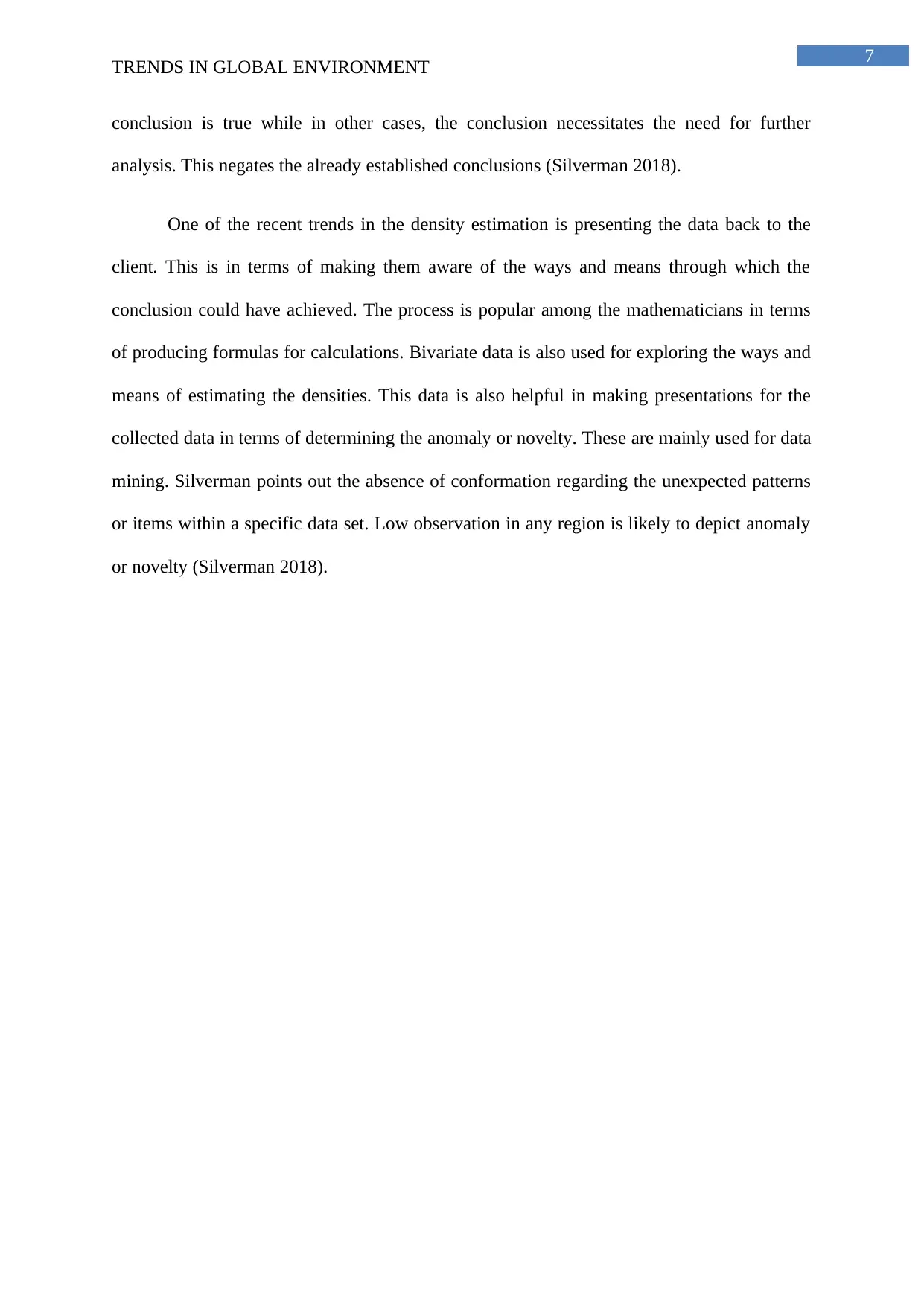
7
TRENDS IN GLOBAL ENVIRONMENT
conclusion is true while in other cases, the conclusion necessitates the need for further
analysis. This negates the already established conclusions (Silverman 2018).
One of the recent trends in the density estimation is presenting the data back to the
client. This is in terms of making them aware of the ways and means through which the
conclusion could have achieved. The process is popular among the mathematicians in terms
of producing formulas for calculations. Bivariate data is also used for exploring the ways and
means of estimating the densities. This data is also helpful in making presentations for the
collected data in terms of determining the anomaly or novelty. These are mainly used for data
mining. Silverman points out the absence of conformation regarding the unexpected patterns
or items within a specific data set. Low observation in any region is likely to depict anomaly
or novelty (Silverman 2018).
TRENDS IN GLOBAL ENVIRONMENT
conclusion is true while in other cases, the conclusion necessitates the need for further
analysis. This negates the already established conclusions (Silverman 2018).
One of the recent trends in the density estimation is presenting the data back to the
client. This is in terms of making them aware of the ways and means through which the
conclusion could have achieved. The process is popular among the mathematicians in terms
of producing formulas for calculations. Bivariate data is also used for exploring the ways and
means of estimating the densities. This data is also helpful in making presentations for the
collected data in terms of determining the anomaly or novelty. These are mainly used for data
mining. Silverman points out the absence of conformation regarding the unexpected patterns
or items within a specific data set. Low observation in any region is likely to depict anomaly
or novelty (Silverman 2018).
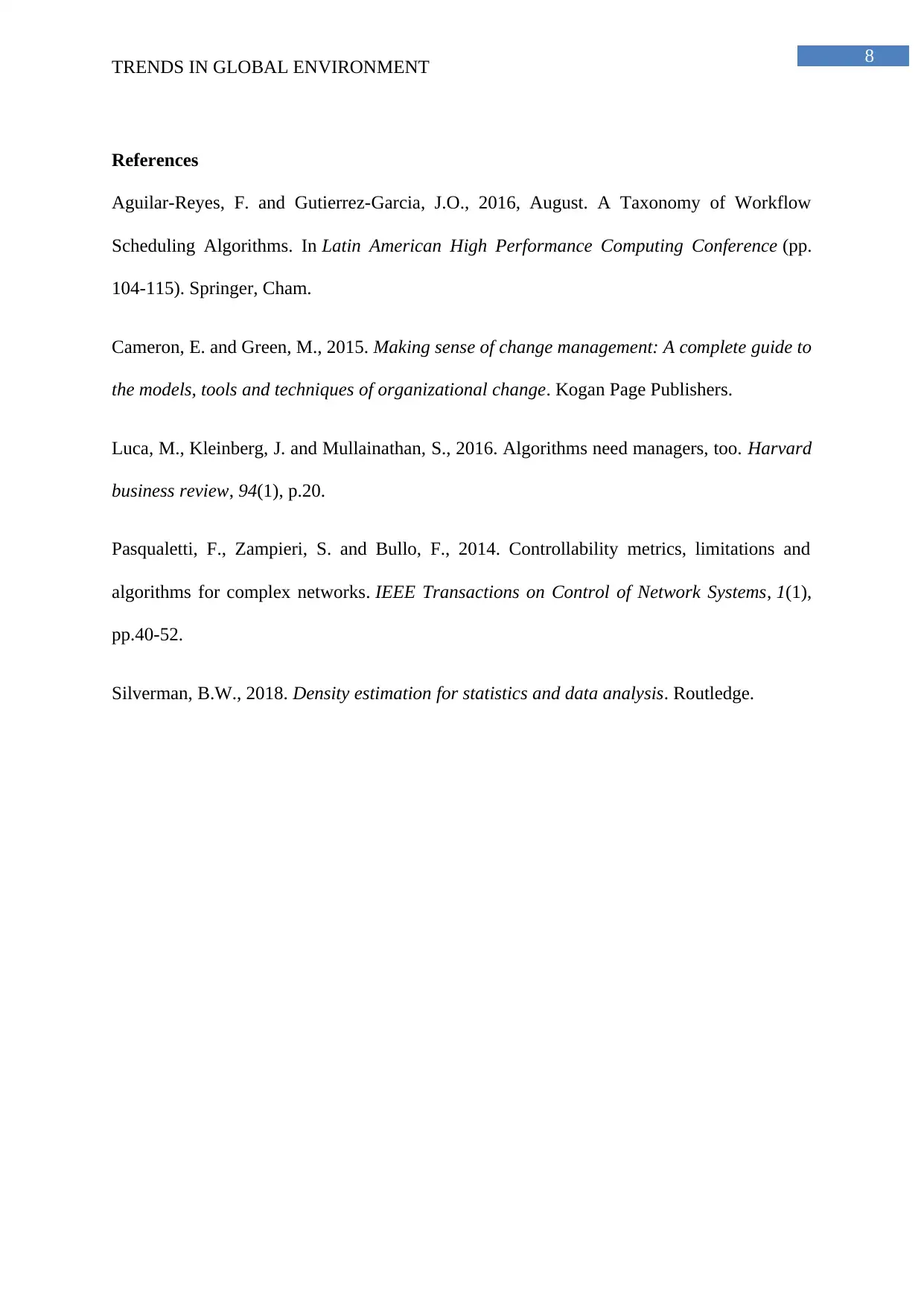
8
TRENDS IN GLOBAL ENVIRONMENT
References
Aguilar-Reyes, F. and Gutierrez-Garcia, J.O., 2016, August. A Taxonomy of Workflow
Scheduling Algorithms. In Latin American High Performance Computing Conference (pp.
104-115). Springer, Cham.
Cameron, E. and Green, M., 2015. Making sense of change management: A complete guide to
the models, tools and techniques of organizational change. Kogan Page Publishers.
Luca, M., Kleinberg, J. and Mullainathan, S., 2016. Algorithms need managers, too. Harvard
business review, 94(1), p.20.
Pasqualetti, F., Zampieri, S. and Bullo, F., 2014. Controllability metrics, limitations and
algorithms for complex networks. IEEE Transactions on Control of Network Systems, 1(1),
pp.40-52.
Silverman, B.W., 2018. Density estimation for statistics and data analysis. Routledge.
TRENDS IN GLOBAL ENVIRONMENT
References
Aguilar-Reyes, F. and Gutierrez-Garcia, J.O., 2016, August. A Taxonomy of Workflow
Scheduling Algorithms. In Latin American High Performance Computing Conference (pp.
104-115). Springer, Cham.
Cameron, E. and Green, M., 2015. Making sense of change management: A complete guide to
the models, tools and techniques of organizational change. Kogan Page Publishers.
Luca, M., Kleinberg, J. and Mullainathan, S., 2016. Algorithms need managers, too. Harvard
business review, 94(1), p.20.
Pasqualetti, F., Zampieri, S. and Bullo, F., 2014. Controllability metrics, limitations and
algorithms for complex networks. IEEE Transactions on Control of Network Systems, 1(1),
pp.40-52.
Silverman, B.W., 2018. Density estimation for statistics and data analysis. Routledge.
⊘ This is a preview!⊘
Do you want full access?
Subscribe today to unlock all pages.

Trusted by 1+ million students worldwide
1 out of 9
Your All-in-One AI-Powered Toolkit for Academic Success.
+13062052269
info@desklib.com
Available 24*7 on WhatsApp / Email
![[object Object]](/_next/static/media/star-bottom.7253800d.svg)
Unlock your academic potential
Copyright © 2020–2025 A2Z Services. All Rights Reserved. Developed and managed by ZUCOL.
